
CHART
BOX
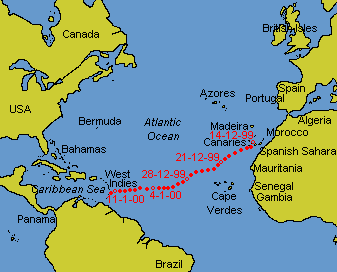
© Copyright 1999-2000 Nigel Jones/MistWeb Software

Many long distance voyagers have left Jersey or mainland Britain full of promises to 'keep in touch' and return their stories to the folk back home. A few of these have done so so publicly through the media or the Internet that I, in years gone by, have waited eagerly for each instalment. In at least three cases that spring to mind, we had full details of their Biscay crossings complete with frayed nerves, sea-sickness and very welcome landfalls (Click here to see ours). But as time went by these stories became less and less detailed until somewhere around the Atlantic crossing or the Panama Canal they dried up altogether, the travellers never to be heard of since.
Why was this? Was it all too awful to report, or was it just too dull? Was the Caribbean so hot and blissful that no-one could be bothered to put pen to paper or to unlock the keyboard?
Well, here's how it feels to me now. The crossing was dull in the sense that many very similar days went by when nothing much happened that had not happened before. The distance from home also has something to do with it. Last summer we travelled away feeling very close to family and friends whom we had just left behind on the pierhead and dock-side. Now, by January, we have made many friends among the voyaging folk. We have told our stories, and got it all off our chests already, with others who travelled the same and very similar tracks. That is not to say that we are not already feeling just a little home-sick, looking forward to and imagining what it will be like to sail back into St Helier harbour, Jersey, again early next summer. And of course, it is blissfully hot here in Barbados... lazy days and long relaxing swims in the clear, turquoise water...
 | CHART |
 | |
| Sketch Maps and Chartlets (not to be used for navigation!) © Copyright 1999-2000 Nigel Jones/MistWeb Software | |
We had plenty of wind. We left the sheltered waters of Santa Cruz harbour in Tenerife at 0930 under a clear, blue sky with a good forecast, a high barometer and 6 to 10 knots of wind under full, plain sail (Click here for a sketch of Rusalka Mist's plain sail plan - the third drawing down the page). It was a warm day and by lunchtime we had the motor off and were settled to a slow, broad reach down the island's east coast. By tea-time the wind had backed to put us on a run. I went forward and lowered the staysail so that it did not blanket the wind from the small, yankee jib. That was the last time I would make it onto the foredeck for many days.
During the evening we cleared the southern tip of Tenerife. By midnight the wind was up to 15 - 20 knots from behind and by 0130 we had seen 27 knots, the beginning of Beaufort Force 7. This is too much for the full mainsail so we harnessed up and went on deck to put a reef in the main. She sailed us comfortably throughout the first night like that.
The next day I noted that it was too calm for the first reef plus yankee, our speed was down to under two knots, but the forecast was for force 5 the next night and force 8 the night after that. These forecasts came through on the Navtex receiver and did not unduly alarm us as the force 8 was for Canarian waters and we hoped to be fairly clear of the islands by then.
The force 5 came as predicted with winds up to 15 - 20 knots again by the evening of the 15th December. The wind faded away again during the next day.
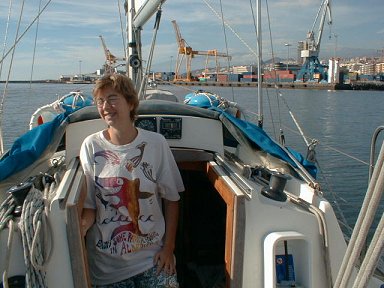 |
| Nicky looking relaxed as we motor through the commercial harbour, leaving Santa Cruz on a warm, sunny December day to cross the Atlantic Ocean |
We had all but forgotten the force 8 forecast when at about 1630 on the 16th, we suddenly had 33 knots of wind from behind and we were powering along at well over six knots through the water. We were quickly up on deck, harnessed on. I went to the mainsail hoping to be able to pull in the second reef without having to round up into this wind. We had put the boat onto a broad to beam reach to try to get some of the pressure out of the mainsail and I remember looking down at the water from my perch on the cabin roof. It was swirling and foaming by at a dizzying speed beyond the narrow side deck. Rusalka, heavily loaded and low in the water, was flying along. The forces on the rig must have been huge, it was amazing that the rudder still had good grip in the water. One slip into the maelstrom and the forces on a body harness and tether would be suffocating and impossible to deal with.
Nicky loosened the main halyard and I pulled with all my might on the luff of the sail. To my immense relief it came, and I began to pull the slides down the mast. When I reached the large steel cringle that marks our second and deepest reef, the wind was still howling in the rigging and my sensation of our speed was not lessened. I decided there and then to keep pulling until the whole sail was down. As the last few feet came onto the boom I felt everything settle down and a feeling of ease come back into the motion.
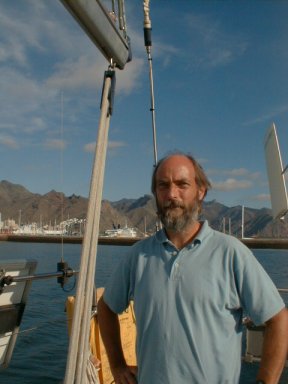 |
| Nobody knows what we have to look forward to when setting out on any journey on a small boat. Nigel lets the self-steering do the work as we motor through the harbour in Santa Cruz de Tenerife. |
To complete the job I removed the halyard from the sail and clipped it to my harness point beneath the boom. Back in the cockpit we lowered the boom to one side of the main hatch, lashed it down and lashed the sail neatly to it. Back onto our course, the wind from behind into just the yankee jib kept our speed between four and five knots. She felt calm and in control.
The seas were big with lines of spume blown down them. We were sailing through a full force 8 gale for the first time. Rusalka was well snugged down and seemed happy with the situation. This was not a squall, the skies were clear. Here at 26° North, 180 nautical miles out from Tenerife, we had found the trade winds: and the trade winds were in a boisterous mood.
The average windspeed dropped back to 25 to 30 knots out of the East and remained similar for the next four days. Slowly during the 20th December we realised that the average wind was down to 20 to 25 knots. This was to hold true for about another 14 days. The 2nd and 3rd of January were calmer with an average wind of 15 to 20 knots then the remainder of our crossing until the 12th January 2000 was made before winds of 20 to 25 knots.
I have been careful to talk about only the average windspeeds so far. This is because I wanted to tell you about the squalls separately. Around the 20th December we were hit by the first squalls. They show up as large, black blobs on radar. We had spent some time trying to avoid one in the Bay of Biscay (Click here for that story) but here they came in gangs of four, six or eight. They usually came at night, when they looked like someone had vacuumed up all the stars from half of the sky. In the day they looked like grey-black clouds that reached right down to the sea.
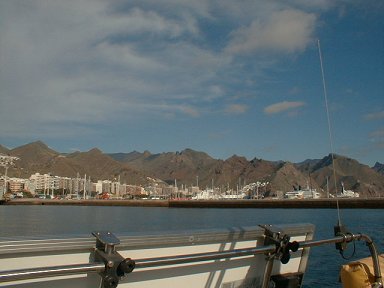 |
| La Marina Atlantico at Santa Cruz had been our happy home for over two months. Now it is dwarfed by the small, Northern mountains of the island as we motor out through the commercial harbour. |
When they hit us, the squalls brought winds back up to 30 to 35 knots with heavy pounding rain. The windvane steering rarely managed to keep our course downwind. We rounded up until the wind was almost on the beam and the boat heeled over to 30 to 40°. Then we bumped along at our usual 4 to 5 knots. We bumped along because the sea was both flattened by the torrential rain and whipped up by the powerful wind. The disturbances were such that we seemed to fall from one wave to the next exactly as if they had been rocks beneath us. The bangs and thuds were quite shocking although not too severe structurally. We weathered these squalls with all the hatches shut tight and both hanging on to the chart table watching the array of instruments that told us our speed and course, the wind speed and direction, our angle of heel and the progress of the squalls on the radar screen.
For the large middle part of the crossing they came nightly, once or twice in each 24 hours. We soon learned that they were no great threat as long as they got no worse. We learned that the small jib we had up may leave us under-canvassed at some points during the day, but it was a great comfort to know that it would be safe up to at least 40 knots of wind and that anything short of that could be weathered with no further action on deck, day or night. Any temptation to try to go faster by re-hoisting the main or poling out the staysail opposite the jib, was soon dissipated by the thought that it would all have to come down in seconds when the next squall hit us. Stories over the short-wave radio of one boat abandoned 500 miles ahead of us and another dismasted and helpless 500 miles ahead of that a few weeks later helped to confirm us in our philosophy that we were not going to mess around with any more sail unless the wind drops dramatically and the squalls cease. Neither of these things happened.
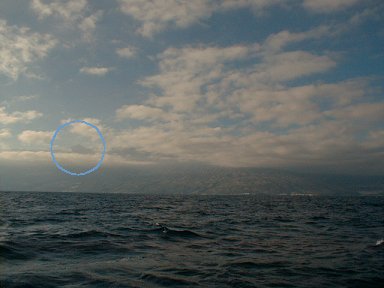 |
| A calm and gentle day passed as Tenerife slipped steadily by to our west. The elusive peak of Mount Teide peeked through the clouds for us. It is circled in the photo, or you'd never find it! |
Our last squall was in daylight and it hit, removing all visibility, just as we were motoring from having checked into Barbadian Customs, Immigration and Health across the anchorage into Carlisle Bay. It lasted only a few minutes, like the rest of them. It was the weather's way of having the last word.
But I must not get ahead of my story here.